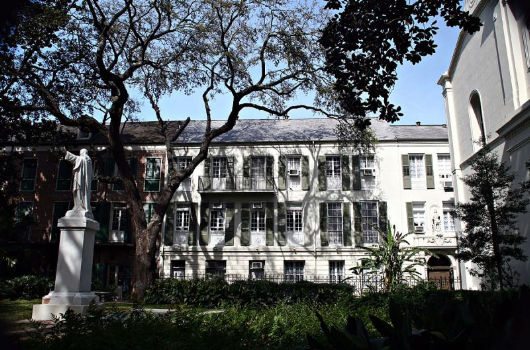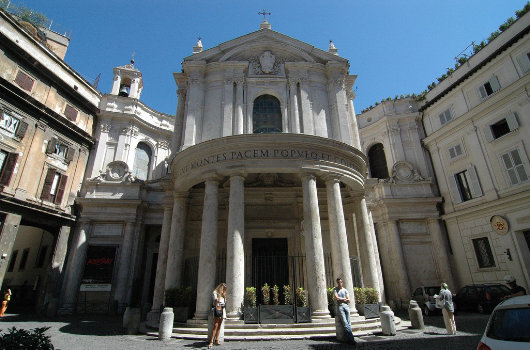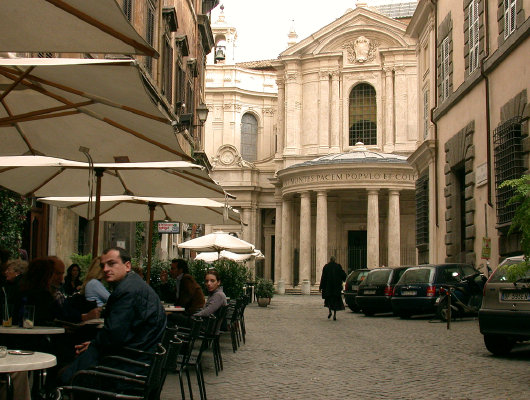Architecture
About Andrew Cusack
 Writer, web designer, etc.; born in New York; educated in Argentina, Scotland, and South Africa; now based in London.
Writer, web designer, etc.; born in New York; educated in Argentina, Scotland, and South Africa; now based in London. read more
News
Blogs
Reviews & Periodicals
Arts & Design
World
France
Mitteleuropa
Knickerbockers
Argentina
The Levant
Africa
Cape of Good Hope
Netherlands
Scandinavia
Québec
India
Muscovy
Germany
Academica
New York’s Dutch Cathedral
The Collegiate Church of St. Nicholas, Fifth Avenue
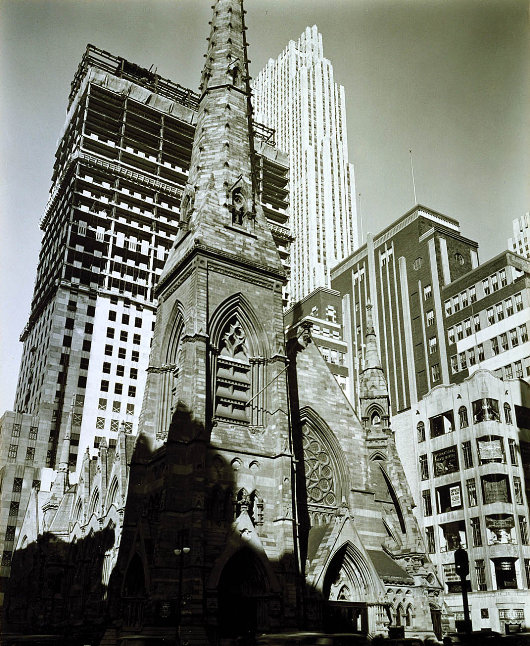
Dedicated a hundred-and-thirty-six years ago, the Collegiate Reformed Protestant Dutch Church of Saint Nicholas on the corner of Forty-eight Street & Fifth Avenue (photographed above by Berenice Abbott) was for many years regarded as the most eminent Protestant church in New York. The Collegiate Reformed Protestant Dutch Church is the oldest corporate body in what is now the United States, having been founded at the bottom of Manhattan in 1628 and receiving its royal charter from William & Mary in 1696. Now part of the Reformed Church of America, the Collegiate Reformed Protestant Dutch Church is actually a denomination within a denomination, and the remaining Collegiate Churches of New York tend to preach a sort of “Christianity Lite”. (The famous Norman Vincent Peale, author of The Power of Positive Thinking and one of the paragons of the “finding a religion that doesn’t interfere with your lifestyle” school of thought, was the pastor of Marble Collegiate Church at Twenty-ninth & Fifth, where Donald Trump is a member of the congregation).
67th & Fifth
One of the most remarkable things about these photos from a 1956 Seventh Regiment ceremony are how traditional the buildings in the background are.
The Kaiser Karl Soldiers’ Homes
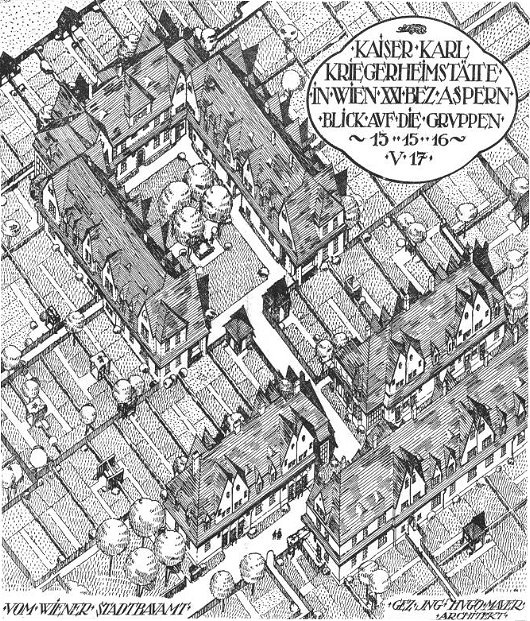
An unexecuted design. The architect later designed a number of housing projects during the First Austrian Republic.
The New York Central Building
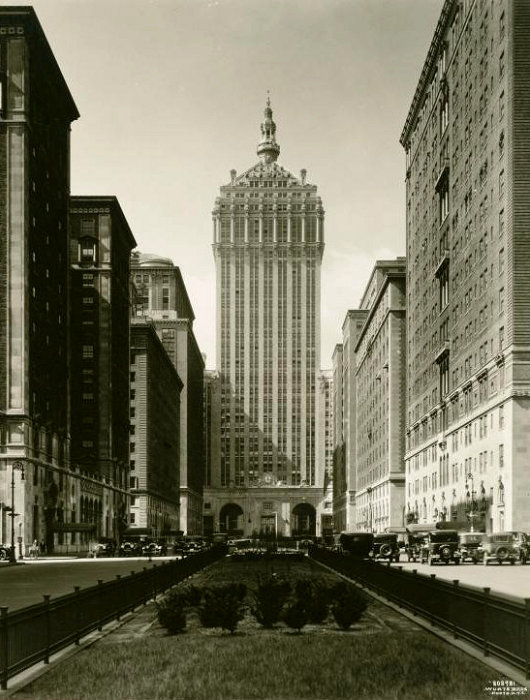
The New York Central building once presided majestically over an equally elegant Park Avenue, which is cleverly directed through the building from the south, emerging through the double arches on the north side. Sadly, while the tower (now known as the Helmsley Building) still stands, the view of it has been marred since 1963 when the Pan Am building was built between it and Grand Central Terminal. When it opened, the Pan Am building was the largest commercial office building in the world, and it was certainly one of the least graceful. The 1960s and 70s were not kind to Park Avenue on either side of Grand Central, and many of the traditional-style buildings have been demolished or re-clad in glass.
The Hanover Bank: A Classical Gem
No. 35, East Seventy-second Street
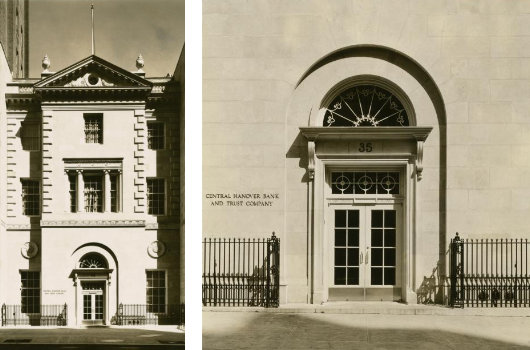
Passing by, as I sometimes do, the Chase branch bank at East 72nd St., I think to myself “There’s a fine establishment, in which I should keep my money”. The thought never jumps from theory to practice, however, as I am a patriot in everything but finance, and keep my florins safe with the Hongkong & Shanghai Bank instead. Nonetheless, it’s a handsome building, and the Central Hanover Bank & Trust Company should be commended for erecting it. Central Hanover merged with the Manufacturers Trust Company in 1961 to form Manufacturers Hanover (“Manny Hanny”), which was taken over by Chemical Bank in 1991, which was acquired by Chase Manhattan Bank in 1995, which merged with J.P. Morgan in 2000, and the consumer & commercial banking arm of J.P. Morgan Chase & Co. is now simply known as “Chase”.
While the original Chase National Bank was only formed in 1877, with all these mergers and acquisitions, “Chase” can now trace its lineage back to the foundation of the Bank of the Manhattan Company in 1799, the second oldest bank after the Bank of New York. But — would you believe it? — “Chase” is now headquartered not in the hallowed caverns of Wall Street but — wait for it — Chicago, Illinois!
The Petit Séminaire de Québec
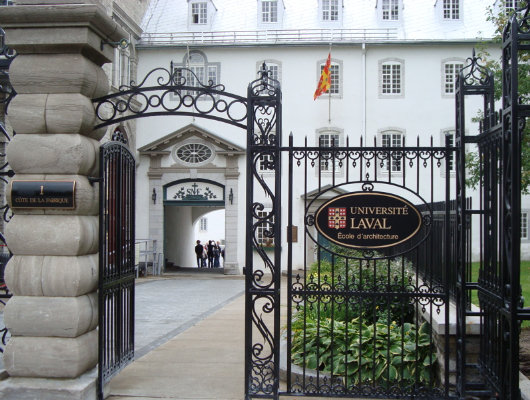
Adjoined to the ancient Cathedral Basilica of Notre-Dame in Quebec City is the Petit Séminaire. The Séminaire de Québec was founded in 1663 by the Blessed François Laval to train priests for the Vicariate Apostolic of New France, and the Petit Séminaire, its secondary school, was founded just five years later to teach both colonial French and native Indian youths. Among the school’s former pupils are four prime ministers of Québec, two lieutenant-governors (as the Queen’s viceregal representative in the province is known), and many other writers, politicians, and important figures of history. The Petit Séminaire survives today as a private Catholic secondary school.
The Municipalidad
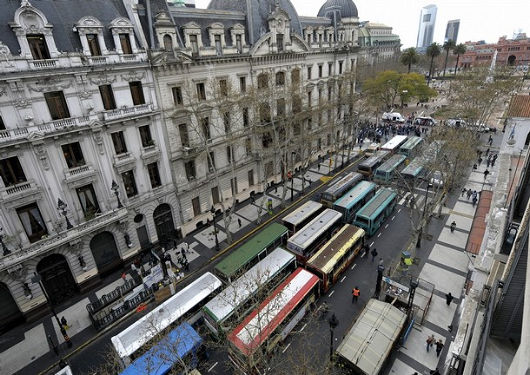
This news photo showing a protest (what else?) of bus drivers on the Avenida de Mayo in Buenos Aires gives a good view of the capital’s city hall. The municipal headquarters is located between the Plaza de Mayo and the former home of the newspaper La Prensa; the Casa Rosada, Argentina’s presidential palace (officially called Government House, Casa del Gobierno) can be seen in the distance at the end of the square.
I’ve long thought they should reduce the auto space by two lanes, one on each side, and double the width of the sidewalks — but that would probably make the bus drivers even more irate.
Santa Maria della Pace
One of my favourite churches in all of Rome is that of Santa Maria della Pace. The best approach is from the alley leading out of the northwest corner of the Piazza Navona, crossing the Via di Santa Maria dell’Anima and making sure to turn left into the smaller alleyway when the little street itself swerves north. Moving forward, the perambulator suddenly emerges into a tiny trapezoidal piazza and having continued for a few paces realizes, almost as an afterthought, that there is something over your right shoulder. There is the Church of Santa Maria della Pace.
Like so many Roman edifices the Church is the work of many centuries. A church dedicated to the Apostle Andrew once stood on the site, and it was on the foundations of that church in 1482 that work on Santa Maria della Pace commenced. Sixtus IV, praying for peace in the Italian peninsula, vowed to build a church dedicated to Our Lady of Peace, and hence the Apostle’s patronage was superseded. While Baccio Pontelli deserves the credit for the church proper, Pietro da Cortona’s splendidly theatrical façade and its enveloping piazza were commissioned Alexander VII in the 1650s.
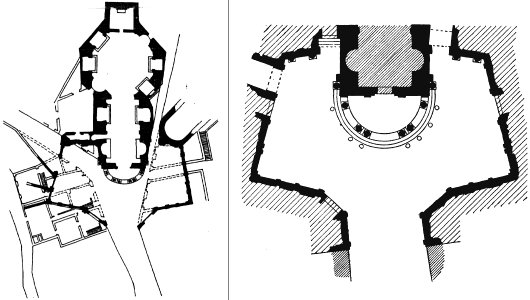
Santa Maria della Pace has a number of connections to the Chigi dynasty. The first prominent member of the Chigi family was Agostino (1465–1520), a wealthy banker and builder of the Villa Farnesina in Trastevere. Here at Santa Maria della Pace, Agostino commissioned the Capella Chigi (not to be confused with the Capella Chigi in Santa Maria del Popolo). Alexander VII himself was a Chigi, and perhaps this explains his patronage of Cortona’s façade and piazza. Among the later Chigi clan, there were a number of cardinals, some of whom were even nuncios, and more recently Ludovico Chigi Albani della Rovere was Prince & Grand Master of the Order of Malta from 1931 to 1951. Anyhow, the Chigi chapel features a fresco initiated by Raphael (and completed by his school), while the adjacent chapel includes sculptural decoration by Michelangelo.
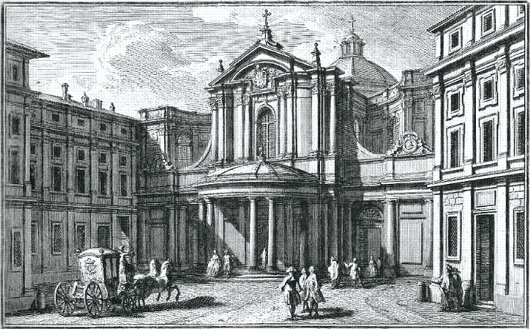
In addition to greats such as Raphael, Michelangelo, and Cortona, the cloister of the church is by none other than Bramante, and indeed was his first work in the Eternal City. Somewhat exhaustively, it doesn’t end there. Santa Maria della Pace has a high altar by Carlo Maderno, a sculpture of the Deposition by Cosimo Fancelli, two small frescoes by il Rosso Fiorentino, and another fresco by Baldassarre Peruzzi who, shall we say in kindness, was a much better architect than painter. There are further works by Maratta and Gentileschi (Orazio, that is — not Artemisia).
A Rundbogenstil Library in New York
The handsome former Astor Library on Lafayette Street

One of my favorite buildings in all New York is the former Astor Library on Lafayette Street in Greenwich Village. Now the Public Theater, it is a superb example of the nineteenth-century German neo-romantic Rundbogenstil (“round-arch-style”) and one of the few remnants of that style in New York. The Astor Library was the legacy of John Jacob Astor, whose will provided for its establishment. Late in the nineteenth century, the Astor Library agreed to merge with the Lenox Library and the Tilden Trust to form the New York Public Library, one of the greatest libraries in the history of civilization. The building was bought by the Hebrew Immigrant Aid Society who tore out the book stacks and used it as a processing station for needy newcomers. In 1965, the HIAS sold it on to a developer who planned to demolish it, but, through a massive civic effort, Joseph Papp and his New York Shakespeare Festival purchased the building and turned it into the Public Theater.
Saskatoon Cathedral
Matthew Alderman’s hypothetical counter-proposal

Matthew Alderman has designed a hypothetical counter-proposal for the new Catholic cathedral in Saskatoon, Saskatchewan which is infinitely more beautiful than the ugly modernist thingamajig that the diocese is actually building. Matt elaborates upon the problematic nature of the modernist design here and here.
So this is why people live in California

Jackson Street, San Francisco: 20 rooms, 9 bedrooms, 7 full bathrooms, 3 half-bathrooms, 7 fireplaces, hardwood floors, 4 storeys, an elevator, 4-car garage, and off-street parking.
Abomination
This act of willful cultural vandalism is noxious in the sight of both God and Man and is a complete and utter abomination. Whoever is responsible for this should be hanged, drawn, and quartered, and buried at a crossroads with a stake through his heart.
Observe the beauty of this building at the corner of Harrison & Penn in Williamsburg, Brooklyn: its classic composition, its complete vernacular ease. And look at the cheap, tawdry, wrongly-colored brick used to hide and ultimately destroy this ordinary gem.
How can the perpetrator of this act sleep at night? It boggles the mind…
The Other Modern
An Architecture of Continuity:
Luis Moya Blanco’s Universidad Laboral de Gijón
In 1944, an undersecretary of Francoist Spain’s Ministry of Labour visited the city of Gijón to attend the funerals of a group of miners killed in a mine collapse. After the solemn rites took place, Turiño Carlos Pinilla met with a group of locals filled with concern for the offspring of the dead workers. All they asked of the bureaucrat was an orphanage; what they ended up with ten years later was a magnificent palace of charity, almost a city unto itself and the largest building in Spain: the Universidad Laboral de Gijón.
An example of Catholic social teaching (which upholds the essential dignity of work and the working man), the “labor university” was founded as a secondary-level institution to teach vocational and technical skills to the children of Spain’s working class. At over 2,900,000 sq. ft. of space, it is more than double the size of the great Royal Monastery and Palace of El Escorial built by Phillip II in the sixteenth century, and was accompanied by over 380 acres of farmland.
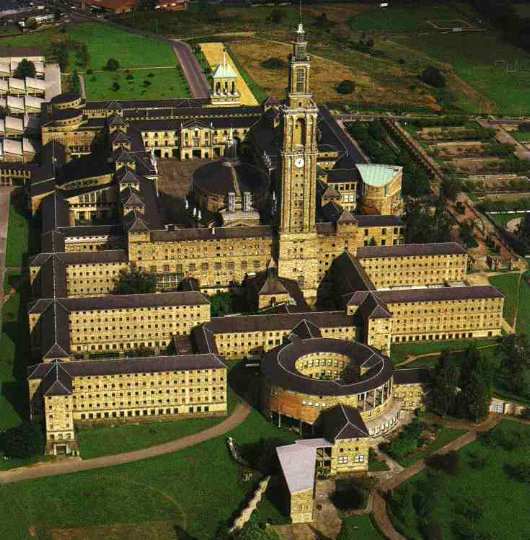
The goal was to accommodate 1,000 students (eventually doubling) from the age of 12 to 16, with residences, school facilities, industrial workshops, working farmland, athletic facilities, and sporting fields. The educational aspect and leadership of the Laboral was entrusted to the Jesuits, while the Poor Clares also had a convent on the premises, performing various household tasks and caring for the girls as their particular charism. (more…)
Q&A: Lady Cochrane Sursock

In a fascinating interview, Canadian journalist and Monocle editor-in-chief Tyler Brûlé talks with Lady Yvonne Cochrane, “doyenne of the Christian East”, discussing Beirut past, Beirut present, and Beirut future.
Update: She is actually Yvonne, Lady Cochrane Sursock, not Lady Yvonne Cochrane as Monocle styles her. Hat tip to Mr. Bond.
Glass-plating the Coliseum
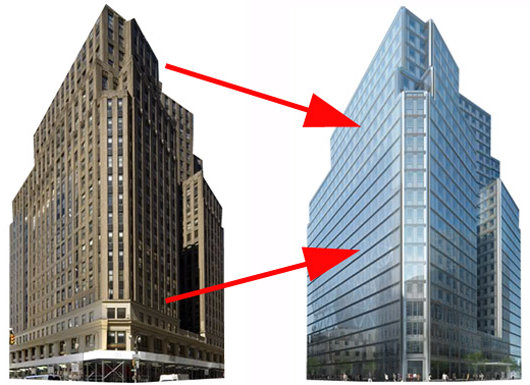
1775 Broadway, formerly the home of Coliseum Books (which I believe got its name from the splendid columns ringing the first two floors, as well as from the nearby now-demolished New York Coliseum), is to be glass-plated and re-addressed as “3 Columbus Circle”. As John Massengale commented, “Because if there’s anything New York City needs it’s another glass-covered office building…”.
Slot Zeist
A country house in the Province of Utrecht

Utrecht is the smallest of Dutch provinces, being little more than a remnant of the once-powerful Prince-Bishopric of Utrecht. The city of Utrecht is the province’s capital and namesake, not to mention the primatial see of all the Netherlands. Just outside the provincial capital is the town of Zeist with its splendid little ‘palace’, Slot Zeist. The house was built from 1677 to 1686 on the ruins of Kasteel Zeist, the castle of the von Zeist family which died out in the fourteenth century (or survived through the Borre van Amerongen family, depending on how you look at it).
Our Lady of Esperanza
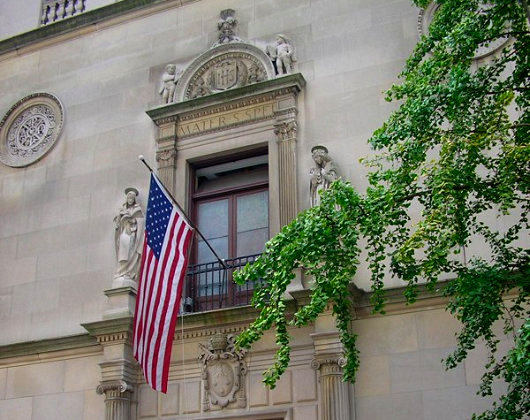
The Church of Our Lady of Esperanza, 156th Street & Broadway. The Church was built by Archer Huntington at the urging of Doña Manuela de Laverrerie de Barril and designed by Huntington’s brother Charles. The sanctuary lamp was a gift from King Alfonso XIII of Spain. The present façade dates from 1924, when the Church was expanded under the direction of Lawrence G. White, the son of Stanford White of McKim Mead & White and himself a partner in his father’s firm.
Search
Instagram: @andcusack
Click here for my Instagram photos.Most Recent Posts
- Amsterdam November 26, 2024
- Silver Jubilee November 21, 2024
- Articles of Note: 11 November 2024 November 11, 2024
- Why do you read? November 5, 2024
- India November 4, 2024
Most Recent Comments
- on The Catholic Apostolic Church, Edinburgh
- on Articles of Note: 11 November 2024
- on Articles of Note: 11 November 2024
- on Why do you read?
- on Why do you read?
- on University Nicknames in South Africa
- on The Situation at St Andrews
- on An Aldermanian Skyscraper
- on Equality
- on Rough Notes of Kinderhook
Book Wishlist
Monthly Archives
Categories

